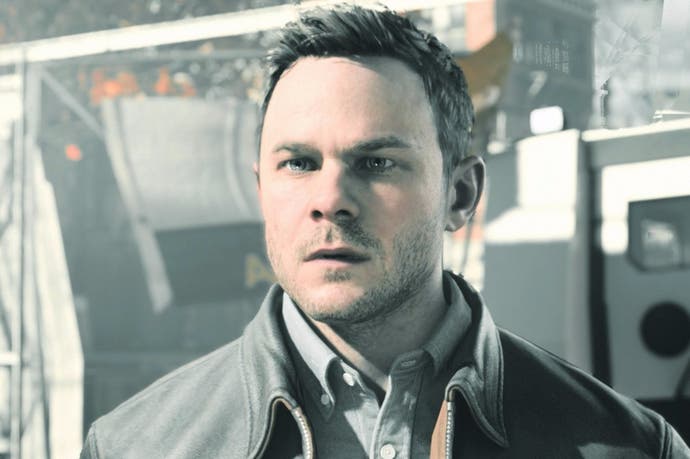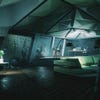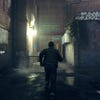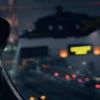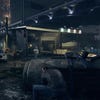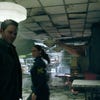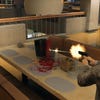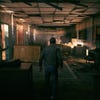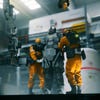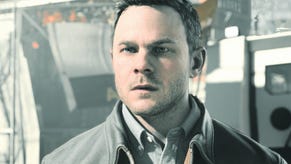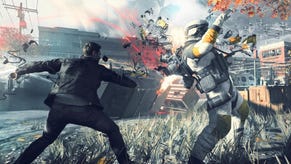Tech Analysis: Quantum Break
Digital Foundry on what works and what doesn't in Remedy's latest.
It's been years in the making, but Remedy's Quantum Break is finally ready. The Finnish team's love of slow-motion will seemingly never die - and it finds a good home this time in a time-bending action title that focuses on moving in and out of time while shooting your way through a character-driven narrative. Within minutes of starting the game it becomes evident that Quantum Break is one of the most impressive looking titles on Xbox One. In a move that exudes confidence, the press has been given access to the game for weeks now - something of a rarity these days - and that has given us plenty of time to fully appreciate just what's on offer. It's not surprising that a lot of controversy has formed around the resolution of the game but as the fervour around this issue dies down, hopefully the wider range of its technical ambition can come into focus.
To start with, Quantum Break is built on Remedy's Northlight engine, a DX12 deferred renderer designed to deliver a seamless experience across large, detailed environments filled with advanced lighting and effects work. The core technology was born from the work carried out for Alan Wake and in fact, the current version of Northlight still shares elements with Remedy's previous game.
While no longer set in the great outdoors, it's still fully capable of delivering a genuine open world - with technology leveraged here to minimise loading. The heavy use of volumetric light shafts also returns in full force alongside the benefits you'd expect in a deferred renderer such as a high volume of dynamic lights. In the move to a next-generation platform, Remedy has pushed for real-time global illumination, physically-based materials, a huge range of unique special effects, and one of the most immersive soundscapes we've heard to date.
While Northlight is a wholly internal engine, it is built upon a seemingly vast number of off-the-shelf technologies, some of which Remedy itself influenced, leading to a very interesting presentation. Most games these days make use of various middleware solutions but it's still remarkable to see how far some of these have come. From AI navigation paths provided by Autodesk Gameware Navigation, audio and geometry occlusion built on Umbra, character performance capture with DI4D, LOD generation using Simplygon, and more - Northlight smoothly integrates a wide range of technologies to great effect.
With so many advanced features and rendering techniques in play, how has Remedy achieved these results on the Xbox One platform? After all, we know that resolution has been sacrificed in order to deliver smooth performance but is the loss in image quality offset by the gains in visual quality? Let's start by examining the strengths of the engine and what it is that makes Quantum Break a next-generation experience.
What Works
- Character models: As evidenced by its past works, Remedy and television go hand-in-hand, but with Quantum Break, the Finnish studio has taken this approach to its logical conclusion. By employing a large cast of well-known actors, Quantum Break finally delivers the TV-like feeling that previous Remedy games evoked. Each actor has been carefully scanned into the game with finely detailed textures, complete with sub-surface scattering, helping to build a proper sense of realism. The actors were then performance captured using a custom version of Dimensional Imaging's DI4D technology, enabling realistic, natural animation and facial expressions during cut-scenes. When taken as a whole, these digital actors feel delightfully realistic and manage to compare favorably with the full-motion video sequences separating the different acts of the game. Sure, the eyes aren't always quite right, with an overly glossy appearance in certain scenes, and the hair is a far cry from the amazing TressFX work seen in Rise of the Tomb Raider, but the overall effect is tremendous.
- Audio: When it comes to audio, Quantum Break presents one of the most active and interesting soundscapes we've encountered in quite some time. The audio engine was built using both Umbra and Wwise middleware solutions enabling proper audio culling, and smooth implementation of sound assets into the game. One way in which this manifests lies in what are effectively audio spheres. Effects, such as reverb and distortion, are applied within sphere space and blended seamlessly with other nearby spheres. These spheres are manually placed around the world and use raycasting to prevent the effects from passing unnaturally through surrounding walls. Raycasting is limited to a single test for distant objects, in order to speed up processing time, but the overall audio budget is around 2ms out of the 33ms available for each frame. The game also uses grain synth to create sound that naturally fits the time bending soundscape - when items freeze or rewind in time, you'll actually hear an appropriately generated sound. The way a paused scream fades into an active one as a panicked person is brought back into the normal flow of time is pretty impressive, for instance. Beyond that, the surround channels are also put to active use creating a very convincing sound chamber.
- Global Illumination: This is a key feature that remains computationally expensive to implement, presenting an interesting challenge when it comes to lighting for this game. Many titles today rely on primarily pre-computed solutions in order to reduce the rendering load and increase performance, but such a solution is incompatible with the dynamic nature of Quantum Break. Scene lighting changes rapidly at various points while many dynamic and breakable objects litter the scenes. Quantum Break solves this issue by employing a mix of screen-space and pre-calculated solutions: irradiance data is reconstructed from irradiance volume based light probes and combined with pre-computed light data in order to calculate direct and bounce lighting within a scene. Screen-space data is used to construct more accurate specular reflections with the probe data being used as a fallback when screen-space data is occluded from view. All of these calculations work in parallel in order to deliver a cohesive whole and it looks excellent.
- Physics: The physics in Quantum Break produce remarkable results in many cases but odd behavior can sometimes spoil the fun - which is why you'll find it on both lists. On the positive side, the limited use of destruction is handled very well with objects breaking apart in realistic chunks based on gunfire, and debris kicking up as you play. After any major battle, portions of the environment appear suitably destroyed - statues are in ruins, chunks of cement missing, and shelves collapsed, just for starters. What we really enjoyed, however, is the way object collisions are handled when time is operating slowly. If you slam into a desk full of objects, for instance, those objects all go flying individually in beautiful slow-motion. Max Payne 2 impressed us more than a decade ago with its robust physics engine - and Quantum Break presents a next-level take on this.
- Filmic presentation: Much has been said about the image quality in Quantum Break, but the soft, filmic look is something we actually feel works well here. This is a game designed to emulate the appearance of full-motion video and it succeeds brilliantly. We'll touch on our issues with the lower resolution approach below, but given that we're looking at a scene built from 720p output, the results are decidedly impressive. The anti-aliasing, lack of temporal shimmering, and the perceptual higher resolution actually work pretty well here.
- Motion blur: Long time readers will know that we're quite fond of high-quality object motion blur. When done correctly, it's an effect that brings real-time rendered graphics one step closer to matching pre-rendered films. The technique as presented in Quantum Break is of a high quality with minimal artefacts. This adds tremendously to the experience and gives every action a suitable sense of weight. Camera motion also receives motion blur but at a lower intensity, which should please those that dislike smearing while manipulating the view.
- Materials: Northlight has been upgraded to support physically-based rendering and, of course, that means we have a full selection of materials authored to support this. The quality of most materials in the game is absolutely excellent - cement, dirt, stone, and metal all generally appear very realistic. It's a cut above other recent attempts at PBR on the platform - games such as Rise of the Tomb Raider and Halo 5 fell a touch short in this regard. When combined with the realistic lighting, the game has a beautifully "hyper-real" appearance that we like.
- Data Streaming: One of the key elements in delivering a seamless experience in a modern game lies in data streaming. Some engines do it well while others stutter and skip as new data is spooled into memory. Quantum Break actually uses a two-dimensional grid system in which data can be loaded dynamically in chunks as needed. Memory usage is kept reasonable and transitioning between different blocks of data remains smooth. There are occasional skips here and there, but by and large, the data streaming works very well here and enables a seamless experience.
- Ambient occlusion: Quantum Break makes heavy use of screen-space effects but the ambient occlusion featured in the game is a cut above the norm. Based on line-sweep ambient obscurance, the results in the game are on par with HBAO+ in many ways, with excellent coverage that looks very natural. This technique seems to handle areas which are sometimes missed by other AO solutions, such as the area beneath a vehicle. The best part is that it requires just 0.75ms of processing time on Xbox One to render out.
What doesn't
- Image quality: While we are impressed with the filmic appearance, that doesn't mean the image is as sharp and or clean as we'd like. As rendering budgets and visual complexity increases, the need for creative approaches to image quality arises. We've been impressed with techniques such as the temporal re-projection used by Killzone ShadowFall in multiplayer as well as the MSAA 'trick' employed in Rainbow Six Siege. Quantum Break's approach renders the game at 1280x720 with 4x MSAA while using four previous frames to reconstruct the image in such a way that resolution appears higher. It's different from the re-projection seen in Killzone in that the image must be re-constructed every time the camera moves - it also varies from Rainbow Six Siege which used MSAA samples rather than past frames, as we see in Quantum Break. The issue here is that while the effect looks very nice in stills, things break down somewhat in motion. Obvious stair-steps become evident whenever the camera is touched and gameplay appears chunkier as the action heats up. In addition, texture filtering is hit or miss with a number of surfaces appearing rather blurry from the gameplay camera angle. All in all, this is one area we expect to see improve on the PC.
- Shadows: Shadow quality is clearly one of the areas where sacrifices had to be made. Jumps between shadow cascades are often harsh with visible artefacts becoming obvious just a couple of metres from the player character. Even at close proximity, the shadow resolution is never particularly sharp. We also observed a number of instances where transitions between shadow maps highlighted a difference in positioning. The filtering used on shadows is excellent, though, and bokeh shapes appear to be used to create the effect of light flittering through trees, but shadows on the whole are still much too resolution for our tastes.
- Temporal ghosting: A side effect of Remedy's approach to temporal aliasing is visible ghosting and trails behind objects. When objects move parallel to the viewport, particularly in front an area filled with screen-space reflections, obvious black trailing artefacts become visible around the object silhouette. This is offset by the sheer number of effects happening in any given seen but, during quieter moments, it can prove distracting. The reliance on screen-space data for reflections and lighting can also prove distracting as information moves in and out of view during camera rotation.
- Physics and other oddities: The physics used in the game are generally excellent but there are a number of objects which lack realistic properties. For instance, players freely push cars around simply by running into them, while other smaller objects can prove impossible to move at all. We were also disappointed to see that inverse kinematics calculations and associated animations were not provided for Jack when in close proximity to objects or walls. Rather than lifting his arms or reacting to the surface, his character model simply clips through the scenery. It definitely proves distracting at points.
- Texture pop-in: The texture work is beautiful in Quantum Break but textures simply refuse to load in properly sometimes. We ran into a number of situations in which very specific textures would remain blurry for upwards of 30 seconds or more. In other cases, certain textures never loaded in at all. Now, it should be noted that this only applies to very specific situations, but this type of bug proves distracting in a game that looks so realistic in other areas.
- Cross-buy: We're not a huge fan of the Windows Store in its current form, but we love the idea of pre-ordering the Xbox One version of the game and receiving the PC version as part of that deal. We saw something similar with Portal 2 on PlayStation 3 but with one major difference - the PC version was included in retail versions of the game as well. With Quantum Break, it's clear that Microsoft is pushing the Windows 10 store and digital downloads, but we still feel customers who buy the retail version shouldn't be denied the PC version. As someone that enjoys building a disc-based collection, this is disappointing.
- Loading times: While data streaming works beautifully in Quantum Break and levels play out without breaks, the times when you must sit through a loading screen, such as when continuing a saved game or loading a chapter, can last quite a long time. Loading can take over a full minute to complete at times. Thankfully, the game's first patch will be ready for launch and is set to improve upon this issue. How much this will have improved remains up in the air, but we're hopeful that users won't have to deal with it.
- Video integration: Quantum Break makes extensive use of pre-recorded video and the results are often great, at least in terms of content. Between each act in the game rests what is essentially a TV show that pushes forward the narrative. These sequences are 24 minutes in length and differ slightly based on choices made during the game. The problem here is that there is a lot of video content on offer but these sequences are not included in the installation. By default, these videos are actually streamed to your Xbox, but it's also possible to download all 75GB of video from the Xbox store. Based on the middleware screen visible at startup, it seems possible that the Bink video is being used here, though we cannot say for certain. Regardless of how these videos were encoded, the final quality does not justify the massive download size.
- Volumetric lighting: As an integral part of the experience in Alan Wake, we were pleased to see volumetric light shafts return in full force here. Unfortunately, the resolution remains very low leading to very noticeable chunking artefacts visible whenever these effects are on-screen. At times, the resolution is low enough that we're reminded of alpha effects seen in Zone of the Enders 2 running on a PlayStation 2 - a beautiful game to be sure, but one running on ancient hardware.
Quantum Break: the Digital Foundry verdict
Ultimately, Quantum Break is one of the most technically accomplished games on Xbox One but it's not without its issues. Northlight produces beautifully detailed worlds with remarkable effects work and lighting but image quality just isn't where it needs to be. The filmic look works to an extent but visible aliasing is still evident in motion making it clear that the solution employed here isn't quite on par with what we witnessed in Rainbow Six Siege. The issues with shadow quality and general stability due to heavy reliance on screen-space data also impacts the look of the game at times.
The real triumph here is the way in which the game's technology benefits the core gameplay. Quantum Break is an absolute joy to play - perhaps the best game Remedy has made to date - and much of that joy is the result of its technology. That perfect mix of high quality animation, effects, and feedback just feels right. It's an highly satisfying game to play.
In these days of Unreal Engine and Unity, it's becoming a rare treat to play a game running on specialised, in-house technology so it was a real treat experiencing Remedy's creation. It has its rough edges, but it's clear that the lofty goals for the project were never in question. The quality of the lighting and the flexibility of what can be achieved in each scene is impressive and it feels as if many of the right compromises were made in order to reach that vision. If you've been looking for a genuine showpiece for Xbox One, even considering its flaws, Quantum Break is it.
